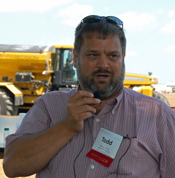 One of the stops on the 2011 CTIC Conservation In Action Tour in Ohio last week was the farm of Todd Hesterman in Napoleon, Ohio. Todd has employed continuous no-till on his 450 acre corn, soybean and wheat operation for 22 years and used yield mapping for more than 14 years and is a strong advocate for doing what he can to help water quality and “still stay in business.”
One of the stops on the 2011 CTIC Conservation In Action Tour in Ohio last week was the farm of Todd Hesterman in Napoleon, Ohio. Todd has employed continuous no-till on his 450 acre corn, soybean and wheat operation for 22 years and used yield mapping for more than 14 years and is a strong advocate for doing what he can to help water quality and “still stay in business.”
 “Our water infiltration rates for heavy rains, we can definitely see an improvement in the quantity of rain water we can accept and not have standing water or running water off the service,” he said. “That’s the biggest improvement we see is soil health and soil quality.”
“Our water infiltration rates for heavy rains, we can definitely see an improvement in the quantity of rain water we can accept and not have standing water or running water off the service,” he said. “That’s the biggest improvement we see is soil health and soil quality.”
Listen to my interview with Todd here: [wpaudio url=”http://zimmcomm.biz/ctic/ctic-tour-11-hesterman.mp3″ text=”Ohio No Till Farmer Todd Hesterman”]
To show the clear difference between tilled and no-till soil, USDA-NRCS Ohio state agronomist Mark Scarpitti did a little demonstration on Todd’s farm by dropping a chunk of soil that had been in no-till for several decades, compared to a similar chunk of tilled soil. You can see what happens in the video below.
CTIC 2011 Conservation in Action Tour Photos
AgWired coverage of the CTIC Indian Creek Watershed Field Tour is sponsored by AGROTAIN
3 Comments on “Clear Difference Between Tilled and No-Till Soil”
What a great visual display of the benefits of NT on soil structure. Kuddos to Mark for putting this together.
What a great visual display of the benefits of NT on soil structure. Kuddos to Mark for putting this together.